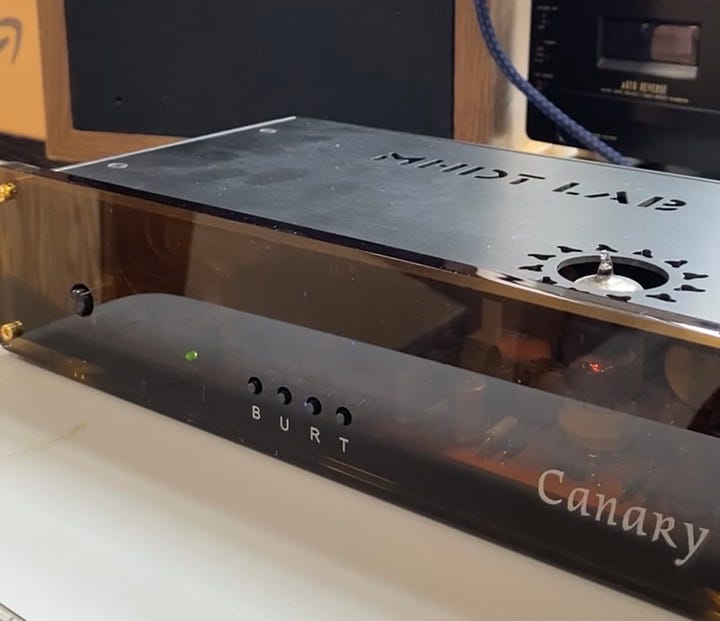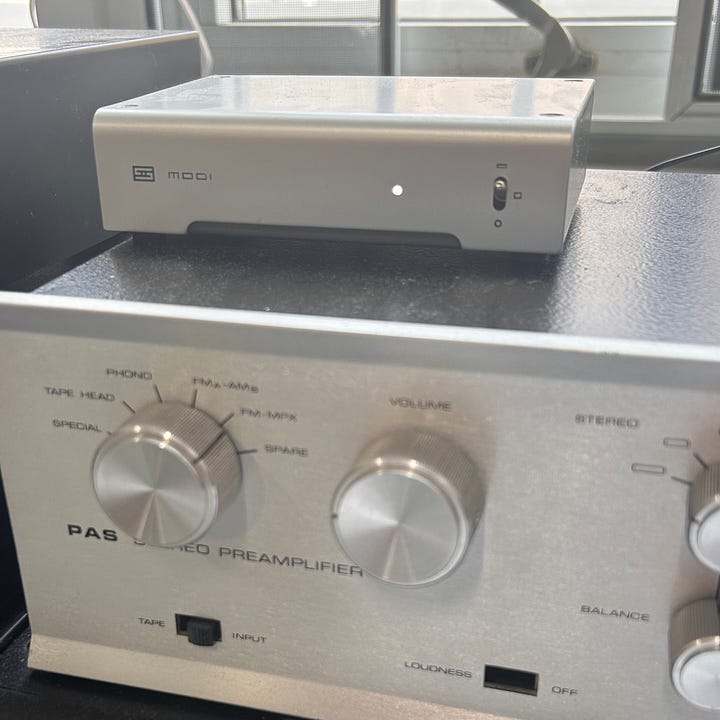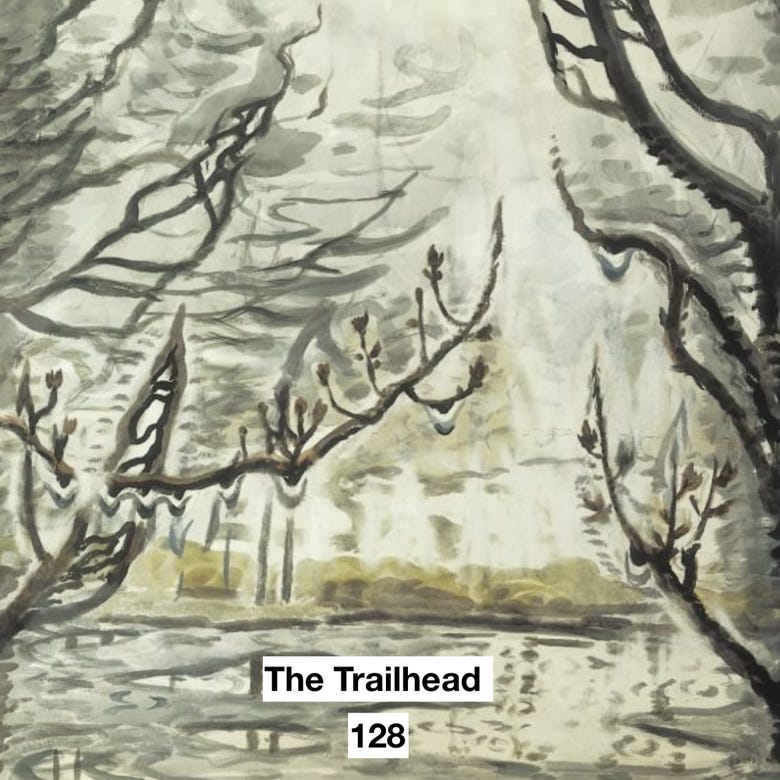#16: All Surroundings Are Evolving
Why You Need a Standalone DAC, Dig of the Week and Bandcamp Friday Picks
Hey, folks. Sorry I missed you last week but the kids were down sick and on spring break so it was truly end-of-March madness around our house.
I also took the week off from radio but I’ve posted the latest show below for those who need to catch up.
I’ve just taken delivery of a Schiit Urd CD transport for review so expect a good deal of content based around the forgotten and neglected format (that’s coming back, they say.) I’m also entering the final couple of weeks living with a MM phono preamp I’ve had in for review. I’m excited and a little nervous about writing it up!
Episode 128 of The Trailhead program featured a lot of new music, including pieces from the great David Cordero on Home Normal, Golden Brown on Aural Canyon, new solo music from Stars of the Lid’s Adam Wiltzie on Kranky, and a second half once again dedicated to jazz.
We heard a killer piece off the new Alice Coltrane live release (that Michael Fremer says is kind of awful on vinyl) along with deep cuts from Charlie Mariano’s fusion period, a killer spiritual jam from Hannibal Marvin Peterson and Coltrane channeled by English greats Elton Dean, Hugh Hopper, Keith Tippett and Joe Galivan.
Listen to the show here and peep the tracklist below.
1. Golden Brown - Terrarium - Kindness (Aural Canyon, 2024)
2. Paul Oednom - Here and There - Equal Parts (Umé Records, 2024)
3. Demetrio Cecchitelli - Intersection - Unity (Rohs, 2024)
4. Slow Reels (Ian Hawgood and James Murray) - Keepsake - Everyday Exotic (Quiet Details, 2024)
5. Domenica Diavoleria - Fun Forest - Orange Clearing (Eiderdown Records, 2024)
6. Adam Wiltzie - Buried At Westwood Memorial Park, In An Unmarked Grave, To The Left Of Walter Matthau - Eleven Fugues for Sodium Pentothal (Kranky, 2024)
7. David Cordero - Tides - Important Small Details (Home Normal, 2024)
8. Infinity Machine - Calling the Spirits - Infinity Machine 002 (DFA, 2024)
9. Alice Coltrane - Journey in Satchidananda - The Carnegie Hall Concert (Impulse!, 2024)
10. Charlie Mariano - Mirror - Mirror (Atlantic, 1972)
11. Hugh Hopper, Keith Tippett, Elton Dean, Joe Gallivan - Naima - Stadt Theatre, Radio Bremen 1977 (Inconstant Sol/Bootleg, 20??)
12. Hannibal Marvin Peterson - Swing Low, Sweet Chariot - In Antibes (Enja, 1977)
My jazz journey began with 70s fusion stuff passed on to me from my father while I was in high school. I got into the heavy hitters from Miles (Kind of Blue) and Coltrane (Giant Steps) but skipped a lot of 50s and 60s “classics” as I headed back for the funky and slightly more outer limit stuff in college and beyond.
Over the last couple of years I’ve sought to expand my jazz horizons and was happy to get exposed to Mal Waldron’s The Quest (New Jazz, 1962) last week during a session at a buddy’s house, warmed by many, many tubes and a pair of Klipsch Cornwalls.
The outing features Eric Dolphy and Booker Ervin on saxes, Ron Carter (on cello), Charles Persip on drums and Joe Benjamin on bass. It was a truly delicious experience to be bowled over by this 62-year-old piece of art.
So, it led me to check out more by Booker Ervin, who I saw has recently been given the Tone Poet treatment for his LP Tex Book Tenor. I perused his Discogs looking for something interesting in the mid-60s from him and came up with The Trance (Prestige, 1967). This set was recorded in Germany in ‘65 and features Jaki Byard on keys, Reggie Workman on Bass and Alan Dawson on drums. Admittedly this one piqued my interest the most as it contains three long pieces.
As a fully licensed, insured and bonded jammer, I believe that long track times are the best indicator of possible transcendence. Yes, there is a lot of crap and chaff in many lengthy jams from artists. From the greats to the mids, all who jam are trying to find something when they go long. And that’s to be respected. Well Booker’s quartet found a real nice place on the title track. It’s a warm and full-bodied choogle that touches on the romantic and the gritty in equal measure. It grooves and glides and gazes outward without ever getting too messy or queasy. It’s just astounding. The second side—containing another Ervin tune and a Kurt Weill composition— isn’t an afterthought and it contains music that can stand close to the first but it may be best experienced after a good, long pause after emerging from The Trance.


I may have been born in the late 70s and my musical obsessions began with physical media but it was the post-Napster explosion of music being shared on the internet that sent me into outer space. Back then, I stupidly ripped all my CDs to some abysmal bitrate in iTunes and chucked the majority of my discs thinking it couldn’t get better. It was around this time I discovered the real good P2P sharing systems (that still operate today) and the myriad of bloggers on Blogspot digging up and posting the most exciting and exotic music one could dream of.
As many did, I downloaded furiously and listened as best as I could—with a cable running out of my headphone jack on my laptop into the AUX input of whatever crusty receiver I was running at the time. This was also as so many radio stations from around the world were upping their streaming game, leading to accessing incredible independent and community stations I previously could never hope to tune in.
It sounded…fine.
Even though the digital music landscape is all but unrecognizable from 20 years ago. Streaming is here, it’s dominant and mostly evil. The cheapness and convenience is what most people want and this zombie-like majority unfortunately gets to decide how music is delivered for all. I only recently caved in to streaming (that’s a topic for another week) but have stayed buying and collecting digital music through Bandcamp as it better supports musicians and labels and offers the best quality listening experience when files are downloaded and played and stored locally.
When I talk to non-record friends and people I meet who I chat casually about music with, I ask how they listen to their digital music. The worst answers are some all-in-one boombox or soundbar or Sonos thingy and the slightly-better bad answer is a cable running out of their laptop to their amp or receiver.
It sounds…fine. They say.
Don’t get me wrong, fine is good. But I want music to grab my soul by the throat and demand every particle of my being to pay attention. And that’s not happening with the digital to analog converter—or DAC—that is resting underneath my keyboard on my MacBook.
I didn’t know anything about DACs or knew what they were until a few years ago when I started getting reacquainted with high fidelity. But nearly every forum, website, YouTube channel I was checking out had tons of space/time devoted to them.
So I took a plunge with the cheapest, well-reviewed option I saw—a Schiit Audio Modi 3+. It’s actually been exactly three years since I bought this piece for 100 bucks and I still have it running in my workspace system (Adcom GFA-545 II amplifier, Dynaco PAS 3 preamp, Advent 2002 speakers).
I couldn’t believe how much better my digital music sounded running through the Modi. Every instrument had its own space, the bass sounded more direct and it just felt more real than it ever had before. I was sold on the importance of upgrading that crucial conversion from the stock afterthought in my computer.
After about a year of running the Modi in my home system with my Tandberg 2025 receiver and Celestion SL6S speakers, I had saved enough and made the jump to a higher plane with a Heed Obelisk SI MK III integrated amp and Ascend Acoustics Sierra 2-EX speakers.
This step up in electronics and speakers called for an upgrade to my DAC and I looked into a DAC that could offer more…something. I wasn’t quite sure what that was. Then I read in a forum someone mentioned how great the old R2R technology was for DACs and downthread was mention of the Taiwanese company MHDT who used some beloved vintage DAC chips in combination with a tube-buffered output and I was intrigued. I found a MHDT Canary for a good price on the seoncdhand market and snagged it.
The Canary offered the chance for an endless amount of tweaking thanks to changing tubes (known as “tube rolling”) which definitely appealed to me. It was also said to present digital music in a very natural and warm manner, another green flag.
It’s here that I’ll say there is a school of thought in audio that noise/distortion that is added to a signal is automatically bad and that the last word in good sound is the cleanest possible delivery from the source to the ears. This school is basically anti-tube electronics and turn their nose up at R2R technology as newer methods and chips have replaced it and measure better in tests I could never hope to understand.
But I trust my ears over some strangers’ numbers and the Canary was a truly wonderful addition to my new system. I wish I had lived longer with my new amp and speakers and my old DAC to be able to better suss out the audible differences but I was just too psyched I couldn’t wait. The Canary makes every digital source sound better, it makes YouTube streams sound amazing but you give it some lossless files and it is very very very close to a great entry to mid level vinyl setup. Sorry to use this very tired term in terms of the sound but IT IS HOLOGRAPHIC. Imagine that, mp3s sounding pretty damn good. It’s possible.
The Canary is quite a bit more expensive than the Modi and you can hear why. But I love the Modi and for the uncritical (and more rocking) listening I do while working most of the time, it’s perfect. But I will get sent some new music to stream while working, and I’ll play it and then start watching the clock, desperate to get home and play the same music on the home system.
Having only deep experience with these two models, I couldn’t really offer any other super solid recommendations other than running down some well regarded brands (Topping, SMSL, Border Patrol, Geshelli Labs, Denafrips) but these two pieces have done wonders for me and my music. If you want to take your digital music to another level, do a lot of reading on some DACs. If you want some of the warmth, look at designs incorporating tubes or R2R technology. If you desire total signal accuracy and transparency and plan to stream a lot of high resolution music, go with a more modern design utilizing ESS, Sabre, or Burr-Brown chips. They say these have their sound signatures but the analog output stage of the unit and how the chip is implemented have way more effect on the piece’s sound. As with amplifiers, beefier power supplies often lead to a better sound as well.
As always, I’m available 24/7 to paying subscribers to help pick a DAC that is right for you and your system. Hit me up!
Today (April 5) is Bandcamp Friday. It’s when the best platform for supporting independent artists waives its fees and pass all money to the labels and artists. Here are five great albums you might want to check out and support.
I’ve been a fan of Rhucle for years and it was Oxtail Recordings who brought the Japanese artist to my attention in the first place. The ambient artist returns to the label this year with Place and it’s contents as enveloping and featherlight as ever.
Portland’s Moon Glyph never misses and today offers Canoga to Haʻikū a new outing from Turn on the Sunlight, a collaborative environmental music conjuring concern featuring Los Angeles’ Jesse Patterson and Carlos Nino.
Guitarists James Elkington and Nathan Salsburg reunite and combine their considerable powers as six string stylists for a new record for Paradise of Bachelors. All Gist closes with a surprising but exquisite reading of Neneh Cherry’s 80s hit ‘Buffalo Stance’ after a journey of tight, melodic rambles and conversations.
Australian trio Panghalina are new to me and I only found this thanks to the lovely cover art while perusing Room 40’s page but what an incredible listen! The trio of Helen Svoboda (double bass, vocals), Bonnie Stewart (drum kit, vocals), Maria Moles (drum kit, synthesizer) tap into some deep inner cosmos that feels completely natural and otherworldly at the same time. It’s noted the album was made thanks to some funding from the Australian government which makes me wonder what living in a proper country would be like.
A couple months ago I became obsessed with Atom Heart Mother—Pink Floyd’s highly experimental, folky, and underrated 1970 LP. It was during a fifth or sixth playback of ‘Alan's Psychedelic Breakfast’ that I thought of Swanox’s 2013 tape Tess (Bezoar Formations). I played the heck out of that and as the Floyd finished up I looked up to see what Swanox had been up to and saw this new one up for pre-order via Not Not Fun (who released the first Swanox in 2010). Rhodyrunner has the same hazy, meditative guitar based psychedelia I fell in love with 10 years ago but with better recording, mastering and, above all, SPACE. Phenomenal stuff highly recomended for fans of the MV & EE / Child of Microtones universe.






Lovely selections Jeff, thanks for including qd15 Slow Reels 💛🙏💚
Thank you for recommending my music. I am especially proud of "Fun Forest".